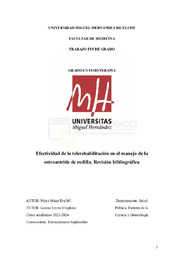Please use this identifier to cite or link to this item:
https://hdl.handle.net/11000/35715Efectividad de la telerehabilitación en el manejo de la osteoartritis de rodilla. Revisión bibliográfica
| Title: Efectividad de la telerehabilitación en el manejo de la osteoartritis de rodilla. Revisión bibliográfica |
| Authors: Pérez Mulet, Eva María |
| Tutor: Ivorra Vilaplana, Lorena María |
| Editor: Universidad Miguel Hernández |
| Department: Departamentos de la UMH::Salud Pública, Historia de la Ciencia y Ginecología |
| Issue Date: 2024-09-03 |
| URI: https://hdl.handle.net/11000/35715 |
| Abstract: Introducción: Este estudio investiga la efectividad de las intervenciones basadas en telerehabilitación en adultos con osteoartritis de rodilla, centrándose en diversas modalidades como programas de ejercicio a través de videoconferencias, educación al paciente y coaching telefónico. La investigación incluye intervenciones específicas, programas de ejercicio y enfoques innovadores como el exergaming. Objetivos: El objetivo principal es evaluar el impacto de estas intervenciones en el manejo del dolor, la función física y la calidad de vida en personas con osteoartritis de rodilla. Métodos: Se realizó una revisión bibliográfica de la literatura científica publicada entre 2014 y 2024, utilizando bases de datos como PubMed, PEDro, Cochrane Library y EMBASE. Resultados: Tras una revisión exhaustiva, se seleccionaron 10 estudios para su inclusión, en los que la mayoría de los participantes eran mujeres, representando entre 60% y 80% de la muestra. La edad media de los participantes fluctuó entre los 55 y los 69 años. En los estudios revisados, la telerehabilitación se destacó por el uso de videoconferencias y herramientas digitales para guiar a los pacientes en programas de ejercicios en casa, mejorando la adherencia gracias al apoyo remoto y coaching telefónico. Las intervenciones basadas en telerehabilitación demostraron ser especialmente útiles para mantener el compromiso de los pacientes con los programas de ejercicio, garantizando un progreso continuo más allá de los entornos clínicos convencionales. Además, la telerehabilitación proporciona un valioso apoyo y orientación remota por parte de fisioterapeutas, lo que contribuye a mejorar los resultados clínicos de los pacientes. Conclusiones: En el contexto de la osteoartritis (OA), se ha demostrado que el ejercicio terapéutico es eficaz en su tratamiento. Además, las intervenciones basadas en telerehabilitación han mostrado ser efectivas en el manejo de la osteoartritis de rodilla, mejorando los resultados clínicos y la calidad de vida de los pacientes. Las recomendaciones actuales sugieren la implementación de enfoques multidisciplinares que integren ejercicio terapéutico, educación del paciente y otras modalidades terapéuticas. Introduction: This study addresses the effectiveness of telerehabilitation-based interventions in adults with knee osteoarthritis, exploring various modalities such as exercise programs delivered via videoconferencing, patient education, and telephone coaching. The research encompasses a set of specific interventions, exercise programs, and innovative approaches such as exergaming programs. Objectives: The main objective is to evaluate the impact of these interventions on pain management, physical function, and quality of life in individuals with knee osteoarthritis. Methods: Scientific literature published between 2014 and 2024 has been reviewed, utilizing the following databases: PubMed, PEDro, Cochrane Library, and EMBASE Results: After a comprehensive review, 10 studies were selected for inclusion, with the majority of participants being women, representing between 60% and 80% of the sample. The average age of participants ranged from 55 to 69 years. In the reviewed studies, telerehabilitation stood out for its use of videoconferencing and digital tools to guide patients through home exercise programs, improving adherence through remote support and telephone coaching. Telerehabilitation-based interventions proved particularly useful in maintaining patient engagement with exercise programs, ensuring continuous progress beyond conventional clinical settings. Additionally, telerehabilitation provides valuable remote support and guidance from physiotherapists, contributing to improved clinical outcomes for patients. Conclusions: In the context of osteoarthritis (OA), therapeutic exercise has been shown to be effective in its treatment. Additionally, telerehabilitation-based interventions have proven to be effective in managing knee osteoarthritis, improving clinical outcomes and patients' quality of life. Current recommendations suggest implementing multidisciplinary approaches that integrate therapeutic exercise, patient education, and other therapeutic modalities. |
| Keywords/Subjects: Physical Therapy AND Physiotherapy Knee Osteoarthritis Telerehabilitation Virtual Therapy |
| Knowledge area: CDU: Ciencias aplicadas |
| Type of document: info:eu-repo/semantics/bachelorThesis |
| Access rights: info:eu-repo/semantics/openAccess Attribution-NonCommercial-NoDerivatives 4.0 Internacional |
| Appears in Collections: TFG - Fisioterapia |
.png)

